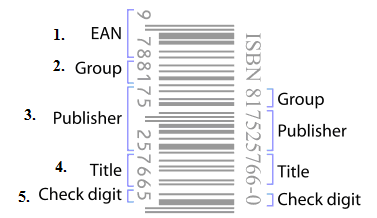
What is ISBN and why do you need it?
 What is ISBN and why do you need it?
What is ISBN and why do you need it?
By Patricia de Hemricourt
The 10 digits ISBN (International Standard Book Number) was created in 1970, internationalizing the 9 digits SBN that existed in the UK since 1966. In 2007 the 10 digits ISBN has been replaced by a 13 digit ones to enable compatibility with the Bookland EAN barcode. The EAN barcode is the book equivalent to the UPC (Universal Product Code) barcode used for product, manufacturer and price information.
It enables book professionals such as publishers, distributors retailers, libraries etc to easily catalog the books they have in stock, have sold, need to order or any other information related to the management of books.
The ISBN only identifies the publisher, the language group of the country the book is published in, and the specific title, and is used to generate the scannable barcode found on the back cover of almost every book sold in the United States today.
Though it necessary for anyone wanting their books to be sold in book stores, distributed by libraries or registered with any official entity, it is optional for publishing with Amazon, as Amazon affects its own identifier (ASIN) to books sold through their services. Other book distribution platform like Smashwords or Barnes & Nobles, on the other hand, will not display your book without an ISBN identifier.
In addition to provide an easy way for book professional to catalog books, it provides information about the book itself to anyone able to read an ISBN Number.
So let’s have a look at the information that figure on this string on numbers for those who can decipher it.
Anatomy of an ISBN code
An ISBN is assigned to each edition and variation (except reprintings) of a book. The ISBN is 13 digits long if assigned after January 1, 2007, and 10 digits long if assigned before 2007. An International Standard Book Number consists of 4 or 5 parts:
for a 13-digit ISBN, a GS1 prefix: will always be 978 or 979, numbers that unlike, for other barcodes where the GSI points to the country code, indicate a product cataloged by Bookland, a fictitious country create with the sole purpose of identifying books at first glance.
- The group identifier: In theory, this indicates which language group the book belongs to. However, an US ISBN could be affected to a book written in Chinese by a US citizen. Similarly, for someone living say, in Israel, the identifier will be 965 whether the book is written in Hebrew, Russian, English, Tagalog or any other language. So, it is more accurate to say that the group identifier indicates a geographical location rather than a linguistic range.
- The publisher code: Looking at the number of digits in the publisher part of the code will give an indication of the size of the publisher. Since the number of digit is fixed, accommodating both small and large publishers is done by playing around with the number of digit affected to the publisher compared to the number of digits for the number of publications by that publisher. In this case the publisher code is 7525, leaving 3 digits for the number of title the publisher can publish under that code. Puffin publisher code, on the opposite, is 14, which leaves 6 digits for the number of books they will publish.
- The item number: In this case, the item number is 766. This means that the publisher has already registered 765 previous books with ISBN, out of the 999 reserved for that publisher under that code.
- The check digit : a one digit used to verify that no mistake has taken place while affecting the ISBN.
